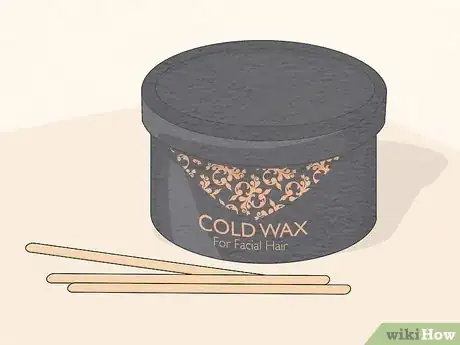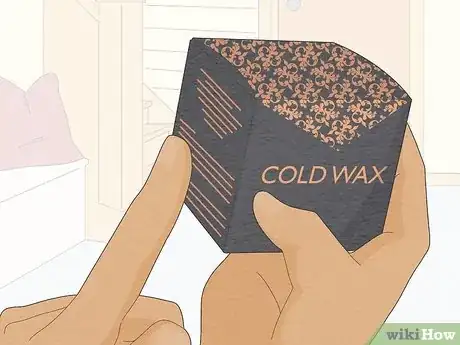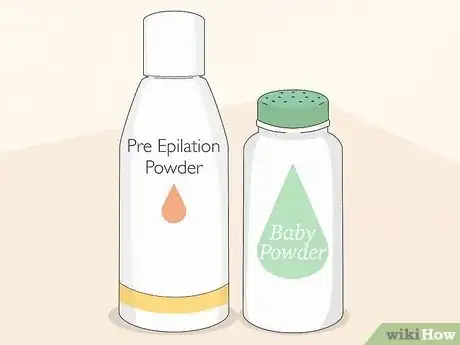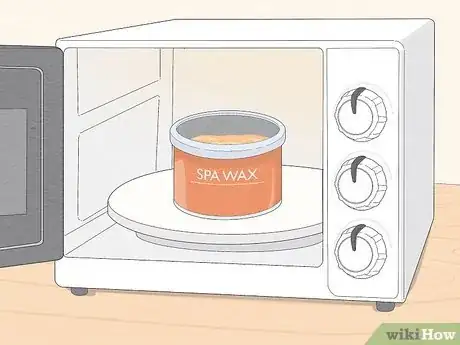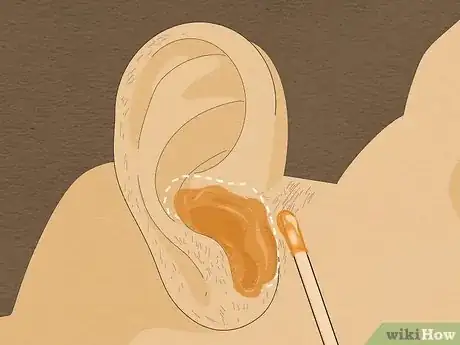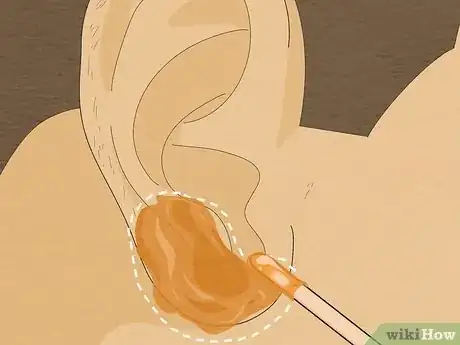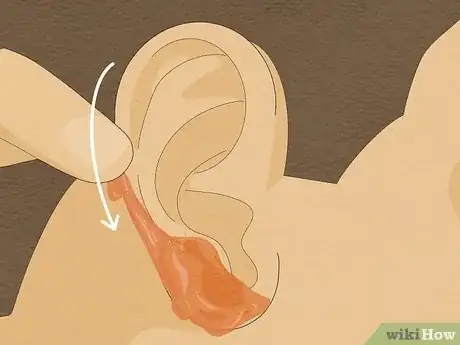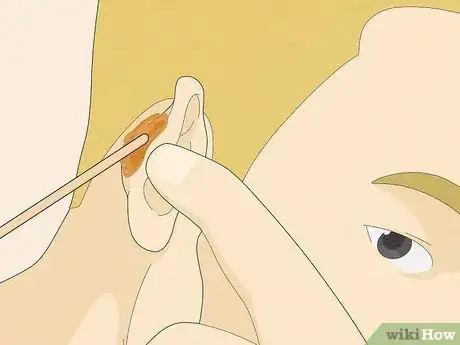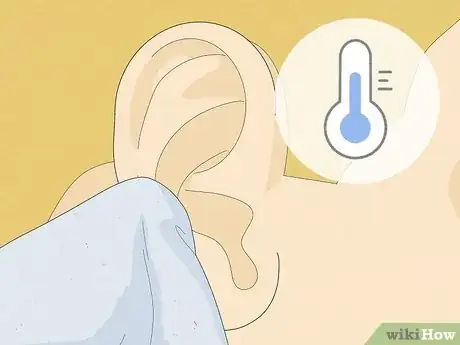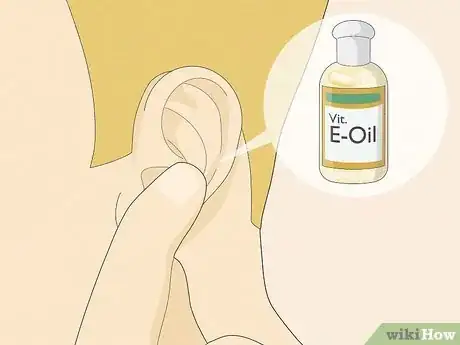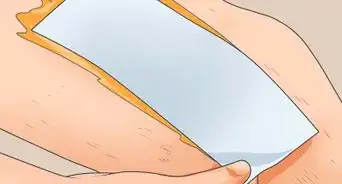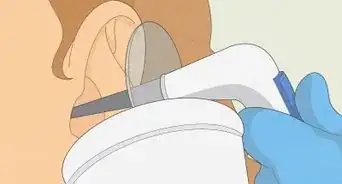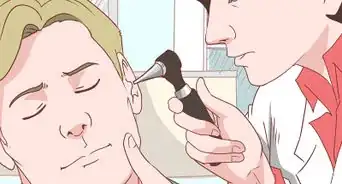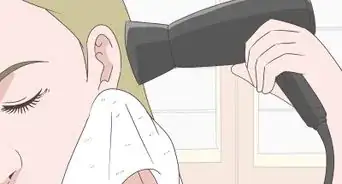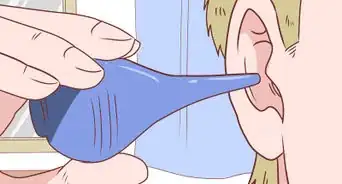This article was co-authored by Laura Martin. Laura Martin is a Licensed Cosmetologist in Georgia. She has been a hair stylist since 2007 and a cosmetology teacher since 2013.
There are 10 references cited in this article, which can be found at the bottom of the page.
This article has been viewed 75,883 times.
Long or unruly ear hairs can be embarrassing and unwanted. The desire to get rid of the ear hair is totally normal, even if it’s not necessary. Waxing your ear hairs is generally not recommended. Wax can drip into the ear canal and cause hearing damage, and the skin on the outer edge of your ear can be extremely sensitive to heat. If you still wish to remove your ear hairs through waxing, proceed with caution.
Steps
Preparing to Wax
-
1Buy an at-home waxing kit. Purchase a wax that is designed to be used on sensitive areas. You can use heated or non-heated wax. Non-heated wax removal products often come with the wax already on a strip, which can provide a more precise application of wax on ear hairs. This is the safest way to wax your ear hair.[1]
- You can also use “cold” wax that’s designed for facial waxing. It’s heated, but only until it’s partially melted, leaving a solid area in the center. Cold wax is not applied with strips.
- Don’t use hot wax to wax your ear hair. It can reach too high a temperature and burn the sensitive skin around the edge of your ear.
- Only use waxes designed for facial use. Never use a body wax on your ears or face.
-
2Check the ingredients. Many waxing kits will have artificial colors and fragrances, along with ingredients like tea tree oil and chocolate. Keep this in mind if you have any allergies. Always check the label.[2]Advertisement
-
3Clean the exterior surface of your ears. Wash your ears carefully with a cloth and warm water. The wax and application cloths will not adhere as well to dirty ears. Let your ears dry completely before moving on to the next step.[3]
-
4Apply a pre-epilation powder. You can find a pre-epilation powder online or at a beauty supply store. A pre-epilation powder helps the skin absorb natural oils and moisture. This ensures the skin is in the best condition possible for waxing. Apply the powder to the parts of the ear you will be waxing.[4]
- You can also use baby powder as pre-epilation powder.
Using the Wax
-
1Warm up the wax. You should first read the instructions that came with your waxing kit. Most at-home waxes can be warmed up in the microwave. If the wax came in a jar, remove the cap and heat it in the microwave for about 20-30 seconds. If the wax came in solid block, cut up a few 1-inch (2.5 cm) chunks and put it in the microwave for 20-30 seconds.
- Test the wax on a small area of skin before use to make sure it’s not too hot.
- Some waxes take a shorter or longer amount of time to heat up.
-
2Apply the wax to the inner lobe. It’s best to start with the most sensitive area first. Use the application stick to apply the wax to this section of the ear. Continue to apply it until you have a nice, solid buildup of wax. You can then leave it on or apply paper or cloth strips on top of the wax.[5]
- If you’re using non-heated wax, you will usually just need to apply the strips directly on top of the ear hair.
- If you’re using a heated facial wax, twirl a blob of wax around the end of a popsicle stick. Let it cool slightly, until it forms a tacky ball. Place the ball just inside your ear and let it harden completely, so that it feels solid when you tap it with a fingernail. Use the popsicle stick to pull out the ball in one firm motion.
-
3Put the wax on your outer ears. Apply the wax to the outermost parts of your ears, including the inner lobes. Again, apply it with the application stick until you have a solid buildup. Use the wax sparingly, since ear hairs tend to be fine and not deeply rooted.[6]
- If you do use a heated wax, make sure it has cooled off somewhat before applying it to the outer edges of your ears.
-
4Place the strips onto the edges of your ears. If you don’t have strips, you can move on to the next step. If you do have cloth or paper strips, press the strips firmly into the wax. Smooth out any creases or edges that are not in contact with your skin. Keep the strips long and thin to conform to the shape of your outer ear.[7]
- Try to apply the wax and strips in the same direction that the hair grows.
-
5Pull the strips or wax away with a quick and clean motion. If you have strips, quickly pull it away in one motion soon after the application of the wax. If you aren’t using strips, dig your nail up under the wax once it is completely dry. Then, pull it off quickly once it has started to lift from digging your fingernails under it.[8]
- Pull the wax back in the opposite direction of the hair growth. Stay close to the skin, and don’t pull up and out.
- You will experience some pain while doing this, depending upon the amount of hair that is removed with each pass.
Finishing Waxing
-
1Check for missed spots. Look for leftover patches of hair. You might find some spots that weren’t waxed properly, so go back and reapply the wax to those areas. If you’re using strips, you may be able to reapply the same strip two or three times in rapid succession, depending upon the amount of wax you use.[9]
- It probably won’t be worth waxing if only a few hairs are leftover. Pluck or, if possible, shave those hairs instead of waxing.
-
2Repeat this procedure on the other ear. Move on to the other ear once you’ve finished waxing the first ear. Apply and remove the wax as you did with the first ear. Again, make sure there aren’t any leftover patches of hair before finishing the waxing process.[10]
- Keep in mind that your ears will be sensitive after the first application, so you might want to wait before reapplying wax.
-
3Clean your ears with warm water. Wet a soft cloth with warm water. Apply it to the areas you have waxed. The warm water should remove the leftover wax.
- Most waxing kits come with a wax remover. If yours has one, follow the instructions to appy it and dissolve any residue.
-
4Close the pores with cool water. After you’ve cleaned your ears, use cool water to close the skin pores and hair follicles. The cold water will also soothe the skin.[11]
-
5Apply aloe vera to the waxed area. Vitamin E, tea tree oil, grapeseed oil, and 1% hydrocortisone cream will also work to soothe the skin. Apply whichever product you have to the sensitive areas and rub it in. This will help to reduce irritation.[12]
Warnings
- Ears are a central point of nerves, and the slightest touch may affect your breathing pattern.⧼thumbs_response⧽
- Avoid waxing your ear hairs if possible, unless you have the guidance of a professional. Hot wax in particular could cause damage to your ear canal.⧼thumbs_response⧽
References
- ↑ http://heavy.com/beauty/2017/04/top-best-waxing-at-home-kit-hair-removal-gigi-sally-hansen-bliss/
- ↑ http://heavy.com/beauty/2017/04/top-best-waxing-at-home-kit-hair-removal-gigi-sally-hansen-bliss/
- ↑ http://heavy.com/beauty/2017/04/top-best-waxing-at-home-kit-hair-removal-gigi-sally-hansen-bliss/
- ↑ http://epilatorgirl.com/at-home-waxing-tips/
- ↑ https://www.youtube.com/watch?v=2mybH45Gkto
- ↑ https://www.youtube.com/watch?v=wKJ8qpLh_UQ
- ↑ https://www.youtube.com/watch?v=TXC17KgbgbA
- ↑ https://www.youtube.com/watch?v=2mybH45Gkto
- ↑ https://www.youtube.com/watch?v=2mybH45Gkto
About This Article
To wax your ear hairs at home, you’ll need an at-home waxing kit, a soft cloth, and some aloe vera. Start by heating your wax according to its instructions, and testing it on a small area of skin to make sure it’s not too hot. Then, apply the wax to your inner lobe using a popsicle stick. Wait until it hardens, and use the stick to pull the wax out in one firm motion. Repeat this step on your outer ears by applying the wax in the same direction as hair growth, and pulling it off in the opposite direction. When you’re finished, clean your ear using warm water and the soft cloth to remove any leftover wax. Then apply aloe vera to soothe any irritation. For more advice from our Cosmetology co-author, including how to prepare your ears before waxing, keep reading!
